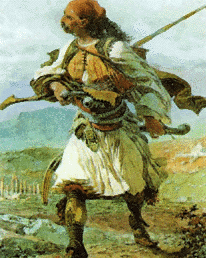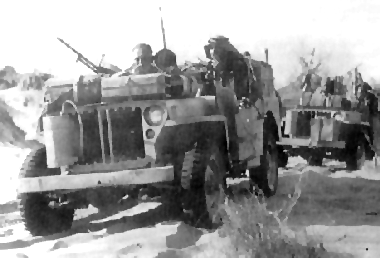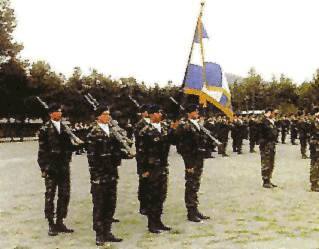

TRADITION
The tradition of special warfare within the Greek Army dates back to as early as the 16th century, when during the years of Ottoman occupation, bands of Greek fighters called Klephtes (brigands) and Armatoli (militia), would come down from their mountain hideouts, conduct lightning raids on Turkish forces, and retreat to the safety of the mountains. During the Greek War of Independence (1821-1827), the exploits of these kilted raiders from Suli, Roumeli, Agrafa, Mani and other regions of Greece had become legendary.
The Turks were mainly concentrated in lowland areas to which the use of cavalry and artillery were more suited, but in the rugged terrain of the mountains their mobility was severely diminished. The hit-and-run tactics of the Greek fighters, though, was perfectly suited to this environment and they inflicted heavy losses on Turkish forces who ventured through their territory. Although the majority of these fighters were part of irregular forces during the war (their allegiance leaned more towards their clans and captains than any centralised command), they later formed the basis of Greece's light infantry force.

In 1940 the Italian Army invaded Greece via Albania (over the Pindos mountain range) and was defeated by an outnumbered and poorly-equipped Greek Army. After the German invasion of Greece in 1941 and subsequent occupation of Greek territory by German, Italian and Bulgarian forces, many Greek soldiers fled into the familiar mountains to become Andartes (partisans), or escaped to North Africa to join Allied Forces.
FORMATION
The nucleus of the Hellenic Raiding Forces was the Sacred Company (Ieros Lohos), a Free Greek unit of commandos attached to the Allied 1st Special Air Service (1 SAS) Brigade during the Second World War. Its members consisted of mainly officers and NCOs who had fled to North Africa after the fall of Greece to Axis forces. After its formation in 1942, the Sacred Company (also referred to as the Sacred Squadron), along with a unit of Free French troops and British commandos, formed the basis of L Detachment, a component of the SAS which specialised in hit-and-run raids on Axis airfields, ports and fuel dumps throughout North Africa.
The Sacred Company was later transferred to the Greek theatre of operations, where they succesfully recaptured several eastern Aegean islands from Axis forces, including the Dodecanese, which had been under foreign occupation for 635 years. After the liberation of Greece from German occupation, a proposal was made for the reformation of the Hellenic Armed Forces under British guidance. This proposal included the establishment of of a small, highly-trained, special warfare unit.

(Above) The Sacred Company, as an element of the Allied 1st SAS Brigade,
seriously damaged the Axis
war effort in North Africa.
When Civil War broke out in 1946, the Greek Government finally decided to form a special warfare unit, primarily to help Greek royalist and British forces liberate territory which was still in the hands of communist-inspired guerillas. The Mountain Raiding Company, or LOK was formed on 20 January 1947 and began operations almost immediately in Greece's mountainous terrain. By 1949, the 4 LOK squadrons were so successful against the communist insurgents that the Raiding Forces Command was expanded to two brigades.
In the 1960s, the Greek Central Intelligence Service, or KYP, and the CIA became secretly involved with training and arming the Lokatzides. A tool of the KYP and CIA, a LOK detachment played a part in the coup d'etat of 1967 by storming and securing the GES, the Army General Staff buildings at Holargos, Athens.
After the fall of the Papadopoulos regime, and the establishment of a democratic republic in 1975, the LOK were dismantled and re-formed as the Raiding Forces, and along with other Hellenic special warfare units, placed under the command of the Hellenic Army's Special Forces Command. Today's Raiders command the same respect amongst their peers in the Armed Forces that their predecessors in the LOK did, and they are still affectionately referred to by the Greek population as "Lokatzides".
